|
The result of a
‘joint effort’
|
|
Ever since the
‘3+1’ concept, from which the new Fiat 500 was developed,
was first presented at the Geneva Motor Show in 2004, the
enthusiasm and interest of the public have shown that the
shape created in the mid Fifties by Dante Giacosa has not
exhausted its extraordinary appeal over the years: even
today, the empathy, familiarity and distinction it
communicates is unchanged, and iconic. And the Fiat Style
Centre has shown an equally extraordinary ability to
recreate the same shapes in an updated, ultramodern form
without detracting in any way from the original content.
To develop such a special car, Fiat decided to adopt a
revolutionary approach, which placed the concept of
‘involvement’ at the centre of the development process. For
the first time in automotive history, the many fans all over
the world were involved directly, through the ‘500 wants
you’ website, and invited to express their wishes for the
new car. These suggestions were then collected by Fiat
Automobiles designers and engineers and converted into
targets to be reached, with solutions and equipment that
were as close as possible to the expectations of potential
customers. So the Fiat 500 really is ‘a car created for the
people, with the people’s ideas’.
A car created for the
people, with the people’s ideas
In order to involve the public in the design of the new 500,
Fiat Automobiles launched a communications project known as
‘500 wants you’, an interactive multimedia platform which,
in advance of the official launch, touched all sectors of
communication: from advertising to viral marketing, fashion
and photography. But it was on the web, thanks to the
www.fiat500.com site that the ‘500 wants you’ project really
came into its own. And the figures confirm that it has been
a huge success: since it went online on May 3, 2006, the
site has been visited by over 3,700,000 users, with over
51,700,000 pages seen, and it boasts a community of 76,000
fans.
‘500 wants you’ was a huge online laboratory, where users
were able to discover the stylistic concept of the new car
for themselves, expressing their preferences, proposing
ideas and contributing to its creation, in a combined,
active manner, for the first time ever. The www.fiat500.com
site collected the suggestions and expectations of the
public, who thus contributed directly to the development of
the product. And through the Concept-Lab, the virtual
laboratory where visitors could model the Fiat concept car,
over 275,000 configurations, suggestions for accessories and
means of customising the new model were submitted.
But, as so often happens on the Internet, the
‘www.fiat500.com’ site was a constantly evolving project,
which continued to incorporate new contents, activities and
initiatives. They have included the DesignBoom international
competition, divided into the ‘accessories’, ‘everywhere’
and ‘lifestyle’ categories, which involved over 5,400 users,
and received about 1,060 projects. 38 videos were also
submitted for the ‘500 take you’ competition, 1,263
proposals for the ‘500 wants a mascot’ competition and about
600 ‘Faces for the 500’, a game that invited people to
associate a facial expression with a chosen part of the 500.
And people showed the same enthusiasm and participation for
the ‘500ology’, the largest online encyclopaedia of stories
and pictures dedicated to the 500, written jointly with the
users, ‘Speak 500’ (a multimedia archive containing over 50
audio files of how the word ‘500’ is pronounced in languages
and regional dialects around the world) and ‘Jingle Box’, a
music player that collected almost 8,600 soundtracks
composed by users, which they could save as MP3 files and
then use on their mobile phones or MP3 players.
And finally, to celebrate the first anniversary of ‘500
wants you’, on May 8, the ‘500x500 online booking’ operation
was launched on the site. This original initiative gave
people a chance to book one of the 500 examples of the ‘500
wants you edition’, an exclusive version of the Fiat 500
dedicated to the site Community, the people who have
collaborated, invented and participated in the birth of the
first car ‘created by the people, for the people’. Although
neither the price nor details of the car have been
communicated, bookings have reached the ceiling at a rate of
one every 40 seconds: a sign of the trust that the people
registered with the site have in Fiat’s capacity to
translate their suggestions into reality.
An ‘appealing’ line that
respects tradition
The Fiat 500 immediately conveys the idea of compactness,
thanks to a lateral section made up of several superimposed
layers and its ‘shell-like’ roof, whose measurements are
decidedly smaller than those of the sides in the plane view.
The proportions and a number of aesthetic features give it
an ‘appealing’ air, but also convey solidity and robustness.
In a total length of just 3.5 metres, the designers have
extended the passenger compartment to obtain a pleasant form
that is extremely luminous in the side view, with a short
bonnet and minimal overhangs. The bonnet folds down over the
sides while the front combines the family resemblance of the
latest Fiat models with the distinctive elements of the
first Fiat 500 with great stylistic harmony. For example,
the strongest reference to the historical car is the
combination of the circular upper headlights together with
full beam lower lights and the ‘whiskers and logo’ unit.
From the side, the waistline slopes slightly at the front to
highlight the robustness and dynamism of the design. The
lateral section proposes a modern interpretation of the look
of the historic 500, but with more essential, modern
surfaces, interrupted by the generous shape of the
wheelarches. It is also possible to see the front and rear
light clusters, because of the way the rounded side links up
to the nose and tail. And finally, the roof pillar forms an
arc which simplifies the design of the glazing which is
continuous and hides the upper edge of the doors with black
profiling.
The rear end of the Fiat 500 features a large shaped,
chrome-plated handle which reiterates the motif of the
registration plate light holder of its forebear that
resembled a bicycle saddle. The rear lights are set between
the edges of the tailgate and they are divided chromatically
by function so that they appear more vertical and farther
apart. The side view of superimposed volumes continues right
to the tailgate, creating a striking wraparound shape. The
rear window ‘cuts’ the tailgate at the sides, creating a
simple modern look for the glazing while a small spoiler at
the top of the tailgate enhances the contemporary look and
improves the aerodynamic efficiency.
And finally, although there are plenty of references to the
past, all the elements are only reiterated on the new Fiat
500 after their place on a modern car has been analysed in
depth, reviewing their functions and materials, or even
finding new uses for them. For example, the famous canvas
roof of the past has now been replaced by a Sky Dome glass
roof. This large roof continues the line of the windscreen,
with a linear, luminous interpretation of the roof,
highlighting the two arcs of the pillars (it is available in
a fixed version, or with an electric opening mechanism).
Another example of a stylistic re-interpretation is found in
the retro design of the front and rear light clusters which
is now combined with the most sophisticated exterior
lighting technology. Produced by Magneti Marelli Automotive
Lighting, they are precious design elements, and the front
light clusters offer DRL (Day Running Light) daytime
lighting as standard: this function is activated
automatically when the engine is started, with a beam
stronger than that of the side lights but lower than that of
the dipped headlights. The DRL system meets current
legislation in some countries that requires motorists to
drive with their headlights on, but makes it possible not to
turn the rear side lights on, thus saving on consumption.
The DRL daytime light is another innovative feature that the
Fiat 500 introduces in this segment for the first time.
The styling of the new car is completed by the broad choice
of metallic and non-metallic colours which creates a large
number of possible combinations, some of which are inspired
by the ‘vintage’ appeal of the original shades of the first
500, while others have a decidedly contemporary look, and
the bodywork can always be chosen to match the fabric or
leather of the upholstery, with a facia the same colour as
the exterior. And finally, the Fiat 500 is the first Fiat
model to use its own name as a logo, positioning it on the
wheel hubs and rims.
Elegance and innovation in a
passenger compartment that will not age
The designers paid the utmost attention to detail, while
focusing on simplicity, which is the leitmotif of the new
model. Simple does not mean ‘bare’, but embraces a
particular stylistic and constructive interpretation that
strives for ‘simplified enjoyment’. The passenger
compartment is airy and roomy, an environment where you can
enjoy the time you spend in the car comfortably and at ease.
|
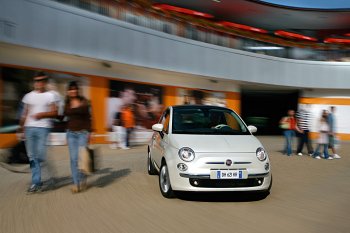
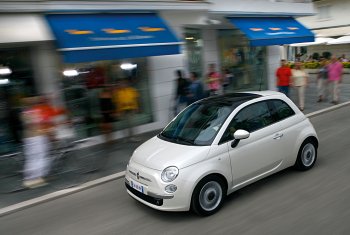
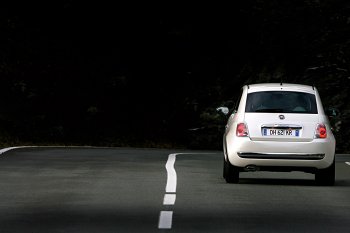
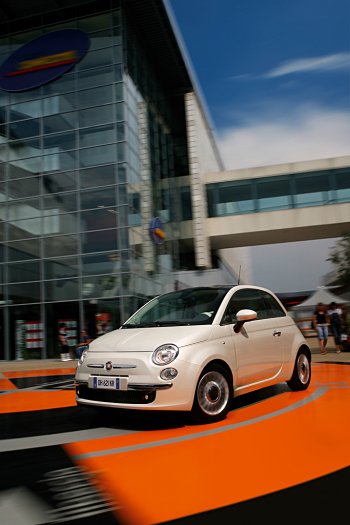
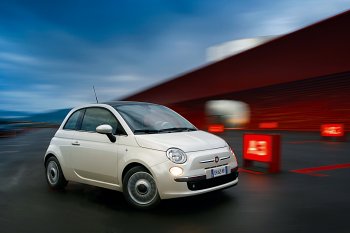 |
|
For the first time in automotive history, the many
fans all over the world were involved directly,
through the ‘500 wants you’ website, and invited to
express their wishes for the new car. |
|
|
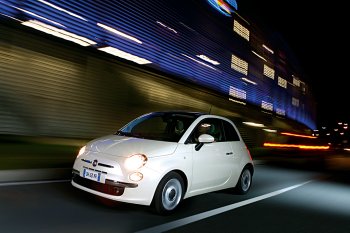
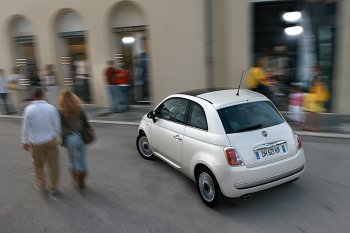
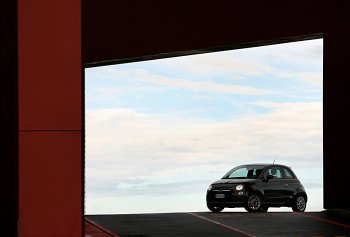
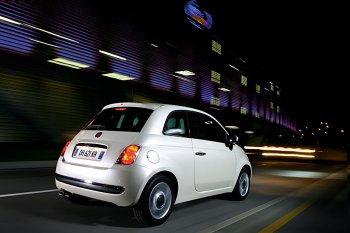 |
|
To
develop such a special car, Fiat decided to adopt a
revolutionary approach, which placed the concept of
‘involvement’ at the centre of the development
process. |
|
 |
|
|
|
It is also an
embracing, protective environment thanks to the large ring
that circles the entire space inside. The structure of
the Fiat 500 cabin sums up the comprehensiveness of the
modern, ergonomic outfit, in a design inspired by the
historical 500. Starting with
the steering column, which is made up of steering wheel and
instruments, grouped in a single panel which contains the
speedometer, rev counter and trip computer, all concentric
and perceptible immediately and simultaneously. These
elements, together with the central console and the
radio-air vent unit, can be ordered in ivory or black, a
choice that influences the character of the car, making it
more ‘vintage’ or sporty. The instrument panel on the Fiat
500 is an ideal blend of retro styling and modern technology
which adapts perfectly to the interior of the car. Built by
Magneti Marelli, it comes in two versions: ‘Comfort’ and
‘Matrix’, and the latter features a dot matrix monitor at
the centre of the panel which displays the pictograms for
the satellite navigation system incorporated in the Blue&Me™
Nav device.
If the upper part of the facia is designed to convey a sense
of refinement and elegance, the lower part conveys
functionality with capacious, open storage shelves, and
small and medium sized drawers for more valuable items that
you want to conceal. The gear lever, which is positioned on
the facia, looks like a refined mechanical component, with
chromed parts and a simple but efficient black knob that is
shiny or chrome-plated depending on the version. The set of
most frequently used buttons was inspired by the telltales
and small levers of the old 500, and is very quick and easy
to use.
The seats deserve a separate mention; the various versions
copy those of the 500 F of the 1960s with the same ‘split’
effect: solid tone fabric at the bottom and the upper
lunette and a head-restraint that match the colour of the
steering wheel. The most lavish version of the new 500 also
offers elegant Cordura fabric upholstery, finished with a
tubular border over the stitching, while the seats and facia
on the sporty outfit show the influence of the racing world,
with leather coloured or black elements, a chrome-plated
gear lever knob and a more encircling shape for the front
seats. Fiat 500 customers can also order prestigious Frau
leather upholstery, choosing from a traditional Black, a
Hide colour that recalls the earlier 500 and an ultra-sporty
Red. The door panels feature a contrast between the part
upholstered to match the seats and the plastic structure
that incorporates a large oddment pocket and the speakers.
The door handle has a chromed ‘hook’ shape that recalls one
of the best remembered features on the door of the
historical 500.
What is more, in spite of its small size, the new model is
amazingly roomy, thanks to careful analysis of the
distribution of the storage units, such as the two
compartments on the facia for the driver and passenger, the
hidden compartment on the passenger side, those in the door
panels, another in the gearbox support and one above the
passenger seat. And the luggage compartment is also quite
capacious (185 litres, or a maximum of 550 litres right up
to the ceiling), and the loading threshold is low to make
loading easier; the rear seat squab can also be folded down.
The rear seat is very comfortable for 2 people, and on all
versions it reiterates the same attention to detail that is
evident in the front seats. To highlight the fact that the
car really is roomy, the upper outline of the squabs is
raised to support and clasp passengers’ backs better. And
finally, a console positioned between the seats near the
tunnel acts as a ‘docking station’, it can hold the usual
small items (glasses and cans), and houses the 12V socket
and USB port to connect a range of functional accessories,
and telematic devices such as an iPod or PDA, or even a
fragrance dispenser which offers the customer a choice of
fragrances.
Engineering and Styling
combined for record time to market
To create the heir to a veritable icon of our times: this
was the goal shared by the engineers and designers who
worked on the new 500. And with this goal in mind, the Fiat
Style Centre and Engineering & Design worked closely
together, applying the most sophisticated methodologies, and
putting into their work all the passion that a similar
project demanded. Like the Bravo before it, for the new 500,
Fiat Automobiles achieved a level of integration between the
set-up, planning and virtual verification methods during the
product development process that is the state of the art in
the motor industry, comparable only with the aeronautical
sector.
Intensive use of virtual checks made it possible to assess a
virtually unlimited number of design solutions rapidly and
early on in the process, guaranteeing the best trade-off of
performance, and strengthening the entire project. As a
result, as with the Bravo, this kept development time for
the new 500 to just 18 months, from the specification
“freeze” to market launch. This record is perfectly in line
with the goals that Fiat Automobiles has already achieved,
borne out, for example, by the fact that European customers
have voted the Panda the best performer in terms of quality
and reliability, thanks to the soundness of the project and
processes. And with the Fiat 500 the reliability and
perceived quality will be even better, due to the care that
has gone into the choice of materials and design solutions.
As a result of the lessons learned from the Bravo project,
the Fiat Group has drafted a plan to implement new
methodologies, which synergetically embraces all the
automotive sectors and revolves around further development
of virtual analysis methods; in parallel, the use of
standardised components was increased, and new design
references were adopted to optimise costs and to curb
weights. One of the first important stages in the
development process that also brings in the competent
Engineering & Design centres, is the co-called ‘feasibility’
stage, during which the preliminary Styling work is analysed
by Engineering, to assess any technical problems that may be
presented by the ‘dress’ covering the mechanical parts, some
of which already existed, and which aspects of performance
may be affected by the styling. In practice, the first CAS
(Computer Aided Styling) mathematical calculations, even
without details such as cuts and mobile parts, seals, etc.,
are combined with already finalised platform calculations,
so that the set-up and layout specialists can then ‘slice
them up’ into specific sections zone by zone, to highlight
the important dimensional parameters and decide how lines
have to be adapted to house the components and to define the
necessary operating spaces.
In the meantime, the aerodynamics team assesses the first Cd
and air flow values for the engine cooling, deriving them
from the fluid dynamic calculation, while the manufacturing
team simulates component pressing in sheet steel, to
highlight any problems related to the shapes. All the data
from these calculations are filtered by the Performance
Engineering team, which defines the trade off necessary if
all the objectives set previously are to be respected.
One of the most critical areas of the 500 project, which
demanded a great deal of creativity as well as patient
refinement, was the nose of the car, which had to
accommodate the mechanicals and the engine as well as
meeting pedestrian safety standards (a problem that did not
exist on the 500 of 1957 because the engine was mounted at
the rear). So with the help of virtual reality, the
specialists tried various combinations for the front
components, until they obtained a new layout that was
compatible with a smaller overhang, after having redesigned
the radiator, widened the front air intake, and repositioned
the foglights, verifying everything with the impact
deformation calculations which confirmed the ‘feasibility’
of the compact nose (very similar to the one on the previous
500).
Another stylistic feature of the old 500 that caused
problems for the feasibility of the new model was the
characteristic curve of the roof at the rear. The
interesting fact was that in the 1950s this line was
established deliberately by the technicians to limit the
roominess in the rear of the car so that it would not prove
too competitive for its more expensive elder sister, the
Fiat 600. The exact opposite to the new 500 of the 21st
century, which was designed to accommodate 4 adults
comfortably, without losing its famous rounded shape. The
ergonomic experts got to work using simulations, and
succeeded in lowering the rear H point, i.e. the reference
point of a human body sitting on the rear seat, so as to
improve headroom. But it was not enough, and there was also
the risk that the foam of the seat cushion would be too
thin, and that the passenger would be uncomfortably aware of
the metal structure of the floor on every bump. Two types of
calculation demonstrated that a solution to the problem did
exist. On one hand, an increase in the ‘bearing capacity’ of
the cushion foam was assessed, so as to absorb the vertical
acceleration in less space, and on the other, a calculation
of the structural rigidity of the bodyshell showed that the
size of the rear crossbeam could be reduced, together with a
‘millimetric refinement’ of the tailgate hinges and the
space necessary for the tailgate to open, and still
guarantee a reasonable amount of headroom.
Still on the subject of the car’s rounded shape, the Fiat
500 has an excellent Cd, without the addition of a spoiler
which would have ruined the car’s attractive line; so by
infinite trial and error, experimenting with the shape of
the tailgate (because in the meantime the first physical
model had been prepared), a final sliver was removed that
made it possible to obtain a Cd reading of 0.325 in the wind
tunnel, an excellent result for a car that is just 3.5
metres long with a rounded shape.
|
|